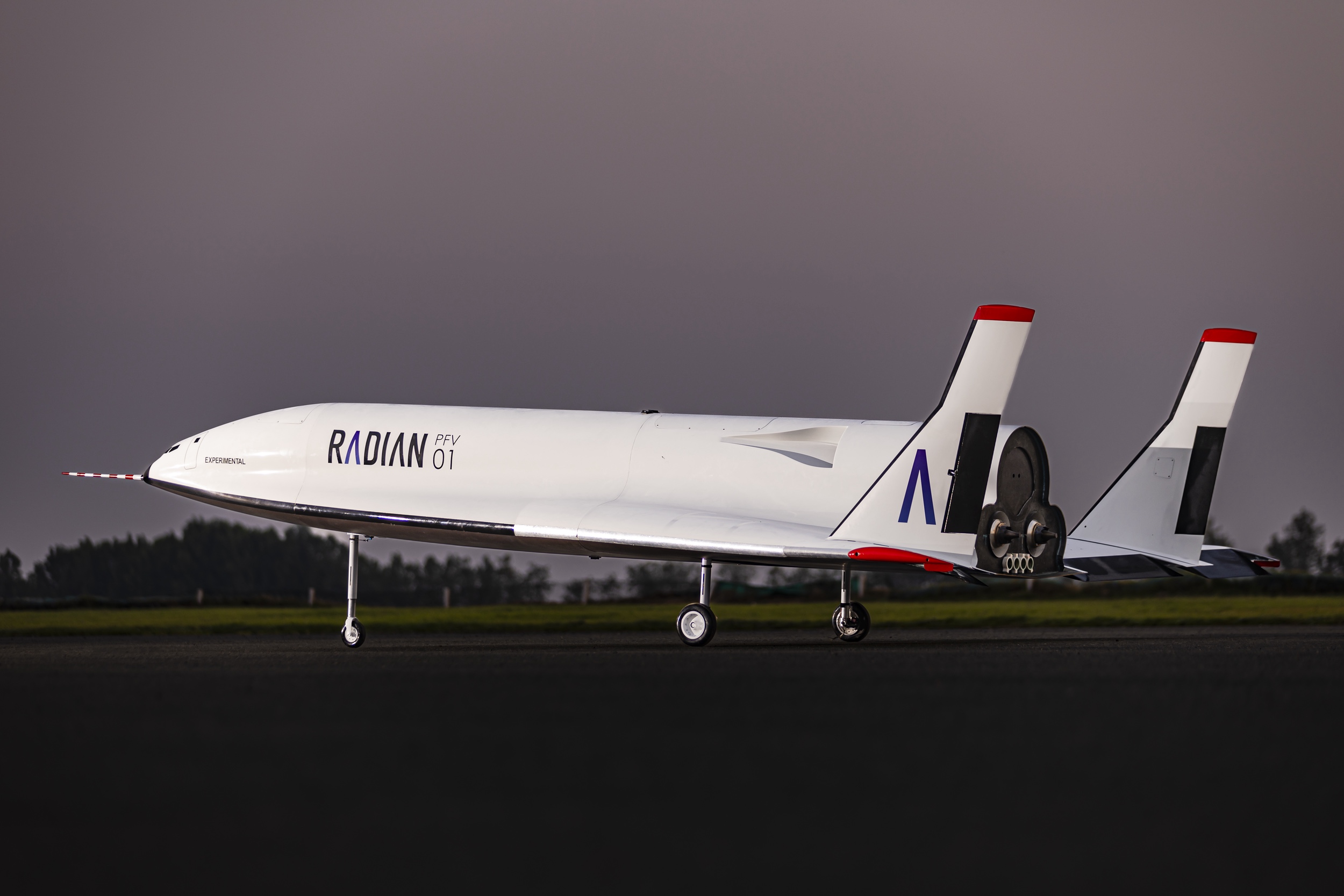The Seattle-based company announced Sept. 25 that it performed an initial series of taxi tests of a prototype flight vehicle it calls PFV01 at an unidentified airport in Abu Dhabi in the United Arab Emirates. The tests included what it called “short hops” by the vehicle as it tested its handling characteristics for takeoff and landing.
PFV01 is designed to test the aerodynamics of the company’s proposed Radian One, a spaceplane that would take off horizontally using a rail sled system more than three kilometers long and reach orbit using rocket engines before returning to a runway landing. The vehicle, as currently designed, could carry up to five people and 2,270 kilograms of cargo to low Earth orbit and return with up to 4,540 kilograms of cargo.
Radian has already done extensive computer modeling and wind tunnel testing of the design, said Livingston Holder, chief technology officer and co-founder, in an interview. “But, we wanted to get a system in the air to see if the analytical work done to date matches our predictions.”
The runway tests, he said, confirmed those models. “It’s an important step,” he said, “validating that the analytical models that we’re using match what we’re seeing in real life.”
Haven’t heard much about this before, and it’s still in the very early stages, but it seems cool.
The rail launch is going to be interesting. Presumably, the sled is separately accelerated, to give the vehicle a little kick and save propellant. It won’t be much, even a 4g acceleration would only get it up to roughly Mach 1.5 before it runs out of rail, but it’s not nothing either. And unless the sleds are single-use, they’ll need to decelerate them somehow.
But man, bring it on! The premise of initially accelerating a vehicle on a rail or launch loop, before the vehicle’s own engines kick in, is probably the closest we can get to SSTO from Earth. At least without using nuclear propulsion.
I’d love to see a layman’s explanation of the challenges and solutions for this.
Like Mach at sea level is going to require more energy than at altitude. How much more? What’s the tradeoff? Clearly they’ve done the math to say the extra energy is worth it.
Also the other tradeoffs - is the sled reused, how much so? Or is it a loss, but the loss makes sense, again, how so?
These aren’t criticisms, I just think it would be nice to see how such systems are planned, knowing any approach is a balance of these tradeoffs (conventional rockets aren’t reusable but don’t have the engineering time and production costs of reuse, for example).
It’s all very interesting, and seeing the high-level tradeoffs would help dispel a lot of armchair dismissiveness (including my own - I’m always suspicious of grandiose “new” ideas).
Well, off the top of my head, the main issues are going to be the sleds, the rails and how much they allow to reduce the mass of the plane itself.
Accelerating the sled with something other than the vehicle’s main engines makes the most sense. Otherwise you’ve just overcomplicated a runway and end up back in the pit of spaceplane-style SSTOs. So assuming they’re gonna boost the sled, how? I don’t think liquid engines have the yeet to get up to a worthwhile speed on the rather short rail. Solid boosters? They have yeet, but once you’ve lit them, you can’t really turn them off and that leaves you with woefully few abort options between ignition and launch. Electromagnetic? Getting enough yeet is a matter of enough (and big enough) capacitors, but the rail erosion is going to be worse from the sheer waste heat. And any attempt at recovery of the sleds will require the rails to be extended to decelerate them. Cause you’ll want to get the vehicle going as fast as possible, within the limits of what the structure and payload (alive or inert) can handle. But once you’ve done that, you’re not gonna hard stop the sled and reasonably expect to recover anything but twisted metal and composites.
The other question is how much is it gonna help in reducing the vehicle’s mass? The friction from doing even Mach 1 near sea level means the vehicle has to be reinforced to handle it, maybe even require active cooling of the hull. So that’s going to cut into whatever extra payload mass they’d get from the launch speed. And the vehicle’s engines will still need to work damn hard to climb up the well, in which case low Mach numbers aren’t going to do much and might actually be counterproductive thanks to the high drag.
My most insane, pie in the sky, they’ll-never-try-this idea? The rail is angled up a mountainside at about a 45 degree angle. Electromagnetically accelerated, it’s basically a huge Gauss cannon and the sled yeets off with a 4g acceleration. By the time it reaches the end, it’s going at about Mach 1.5, at an altitude of 2-3km, at which point the vehicle lights its engines and disconnects from the sled (Spinlaunch has shown that fraction of a second precise release is possible). The plane continues to ascend, the sled just fucking runs off the rail and coasts to peak altitude, then deploys parachutes to descend back to the ground. But this is an entirely unreasonable idea. Construction and maintenance would be ludicrously complicated and harried by environmental concerns. The energy required would probably be comparable to that of a small town. There’s way too much risk of the sled colliding with the plane at the end of the rail, not to mention the parachute descent. On the other hand, goddamn, it would be awesome!
The skepticism is reasonable. The theoretical principles are sound and there’s a lot of math (done by actual scientists and engineers, as well as sci-fi writers) to show that, in some form, it would work. But this is a huge undertaking that’s never really been tried before, so no one really knows how difficult (and expensive) building and operating it is going to be. Honestly, I expect this to fall apart before they begin high altitude suborbital tests of the rail launch system. On the other hand, it’s such wonderful sci-fi shit that I can’t help but root for them. If they can secure the funding to continue developing this, it’s gonna be fascinating!
I expect this to fall apart before they begin high altitude suborbital tests of the rail launch system. On the other hand, it’s such wonderful sci-fi shit that I can’t help but root for them
Same. I don’t have high confidence that they will succeed, but I’m glad that people are trying this sort of thing, just on the off chance that it is feasible.
They seemed like vaporware. I didn’t expect a test like this so soon. Cool.


